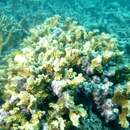Australogyra: Brief Summary
provided by wikipedia EN
Australogyra is a genus of cnidarians belonging to the family Faviidae.
The species of this genus are found in Southerneast Asia and Australia.
Species:
Australogyra zelli (Veron, Pichon & Best, 1977)
- license
- cc-by-sa-3.0
- copyright
- Wikipedia authors and editors
Description
provided by World Register of Marine Species
'This species was described in Part II, p. 110 as Platygyra zelli, where it was noted that “the ramose growth form of this species, combined with the normal lack of a columella, separates it from all other Platygyra and makes its generic affinities obscure... As this is a monospecific genus, its characters are those of zelli. [“Colonies are up to 25 cm high and have main branches 1.5–3 cm in diameter. Actively growing branch ends are composed of intricate arrays of thecae and elongated septa reminiscent of branch tips of Hydnophora rigida on a larger scale. Dead skeleton forms the base of most colonies. The valleys are short and usually monocentric. The walls are thick (2–4 mm) especially towards the base of colonies where skeletal parts are heavily calcified. Valleys are usually shallow with smooth blister-like floors. There is usually no sign of a columella, although elongated, recurved septal dentations are occasionally found and occasionally these form a distinct columella. The septa are similar to those of P. daedalea and P. lamellina. They are dentate and have fine granulations on their sides. Some dentations are twisted to form tiny horizontal plates fringed with granulations, presumably sclerodermites.” (Veron et al., 1977: 110)]' (Veron and Pichon, 1982: 138)
Diagnosis
provided by World Register of Marine Species
Colonial, with intracalicular budding only. Corallites monomorphic, uniserial and ramose; monticules absent. Walls fused. Calice width medium (4–15 mm), with medium relief (3–6 mm). Costosepta confluent. Septa in < 3 cycles (< 24 septa). Free septa present but irregular. Septa spaced 6–11 septa per 5 mm. Costosepta equal in relative thickness. Columellae trabecular but compact (1–3 threads) or absent, < 1/4 of calice width, and continuous among adjacent corallites. Paliform (uniaxial) lobes absent. Epitheca well developed and endotheca low-moderate (tabular). Tooth base at mid-calice circular. Tooth tip at mid-calice irregular; tip orientation perpendicular to septum. Tooth height low (< 0.3 mm) and tooth spacing medium (0.3–1 mm), with > 6 teeth per septum. Granules aligned on septal face, perpendicular to septal margin; weak (rounded). Interarea palisade. Walls formed by dominant trabeculotheca and partial septotheca; abortive septa absent. Thickening deposits fibrous. Costa center clusters weak; < 0.3 mm between clusters; medial lines weak. Septum center clusters weak; < 0.3 mm between clusters; medial lines strong. Transverse crosses absent. Columella centers aligned.

